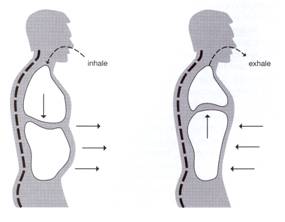The irony is not lost on me that I am battling pneumonia while writing a post on the importance of good respiratory support! Haha! I am very passionate about this topic because I have seen first hand how it can help a multitude of areas including sensory, speech, and fluency. When we feel anxious or nervous, what do we tell ourselves? Stop, take a deep breath in, and exhale out all the stress. Respiration alone does not solve everything, but it serves as a good base, a jumping off point that helps us have more success as we tackle the other goals ahead.
Step 1. Diaphragmatic breathing or what some refer to as belly breathing is when we access our diaphragm upon our inhale. When you inhale, your belly should move outward (but don’t force it) and as you exhale, the belly moves inward. This helps pull more air in while also reducing tension from the laryngeal and pharyngeal areas which will allow for better control of exhaled breath for improved vocal quality, intonation, stressing, rhythm, phrasing, and correct realizations of phonemes.

Step 2. Now that we have established the correct breathing pattern, we will work on increasing the vital capacity of lungs along with facilitating control of inhalation and exhalation. We will start by having the client breath in (through nose) to a count of 3; hold for a count of 3; and then exhale (through mouth) for a count of three. Repeat this several times while extending exhale to counts of 4, 5, 6, and on to 10. Make sure there is no neck or facial tension and no shoulders-to-ears action happening.
Step 3. Next, we will further address improving the strength and coordination of the respiratory muscles through a series of exercises listed below:
- Breathe in to a count of 3 and exhale breath on /h/ or /s/, sustaining sound for up to 20 seconds.
- Practice increasing/decreasing intensity of /s/ as follows (use /a/ if client cannot produce /s/:
- SSSSssss (louder to softer)
- ssssSSSS (softer to louder
- ssssSSSSssss (soft, loud, soft)
- ssssSSSSssssSSSSssss (soft, loud, soft, loud)
- Practice exhaling in a rhythmic pattern using /s/ or /a/ using __________for long sound and ____ for short sound:
- _________ ____ _________ ____
- ____ ____ __________ ____ ____ __________
- ____ __________ ____ ___________ ____ _________
- ________ ___ _________ _________ ____ ____ ____ _________ ____ ____
The exercises listed above were adapted from Robertson, Sandra J. and Thomson Fay. 1982. Working with Dysarthric Clients: A Practical Guide to Therapy for Dysarthria. Arizona. Communication Skill Builders. I use these exercises as a base for building a strong foundation for improved phonation, articulation, and prosody. I spend a lot of time during the first 4-6 sessions on these exercises and will taper off once I feel the client is using correct respiratory control. If at any point during treatment (could be 3, 6, or 12 months later) I notice an increase in disfluencies and/or decrease in prosody, I will work through each of these exercises again to regain better control.
It is important to note that these exercises can be done with a variety of clients because good respiratory control benefits all. It is even helping me as I am in the final stretch of this dreadful pneumonia and also when I am under a tight deadline! Try it out and let me know what you think! Namaste.

